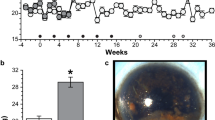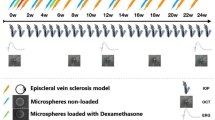Abstract
Purpose
To establish a rat glaucoma model with chronic intraocular pressure (IOP) elevation induced by microbeads suspended in sodium sulfate–sodium hyaluronate.
Methods
Chronic elevation of IOP was induced unilaterally by injecting polystyrene microbeads, suspended in 4 % sodium sulfate and 3 % sodium hyaluronate, into the anterior chamber. The microbead suspension was injected through either the clear corneal (CC) or sclerocorneal (SC) tunnel. IOP changes were monitored up to 8 weeks after injection. The loss of retinal ganglion cells (RGCs) was assessed using fluorogold retrograde labeling of RGCs. RGC axons were evaluated by immunohistochemistry and immunoblotting.
Results
The resulting IOP elevation was maintained up to 3 weeks after the intracameral injection of microbeads through the CC route and up to 4 weeks after injection through the SC route. The density of RGCs was significantly reduced at 4 weeks after injection, with the SC route leading to more RGC loss than the CC route (p = 0.037). The neurofilament immunoreactivity and protein levels in the optic nerve were also significantly reduced at 4 weeks after injection. Some eyes in the SC route cohort received re-injection of the microbead suspension at 4 weeks after the initial injection, which led to an elevated IOP more than 8 weeks after the initial injection, and eventually a 27.5 % loss of RGC density compared with the control eyes.
Conclusion
The intracameral injection of microbeads suspended in hyaluronate effectively produced chronic IOP elevation and subsequent RGC degeneration in rat eyes. The sclerocorneal tunnel approach yielded a longer period of IOP elevation than the clear corneal approach. Our modified microbead injection offers a reliable high-pressure glaucoma model.




Similar content being viewed by others
References
Pang IH, Clark AF. Rodent models for glaucoma retinopathy and optic neuropathy. J Glaucoma. 2007;16:483–505.
Johnson TV, Tomarev SI. Rodent models of glaucoma. Brain Res Bull. 2010;81:349–58.
Shareef SR, Garcia-Valenzuela E, Salierno A, Walsh J, Sharma SC. Chronic ocular hypertension following episcleral venous occlusion in rats. Exp Eye Res. 1995;61:379–82.
Kanamori A, Nakamura M, Nakanishi Y, Nagai A, Mukuno H, Yamada Y, et al. Akt is activated via insulin/IGF-1 receptor in rat retina with episcleral vein cauterization. Brain Res. 2004;1022:195–204.
Ueda J, Sawaguchi S, Hanyu T, Yaoeda K, Fukuchi T, Abe H, et al. Experimental glaucoma model in the rat induced by laser trabecular photocoagulation after an intracameral injection of India ink. Jpn J Ophthalmol. 1998;42:337–44.
Levkovitch-Verbin H, Quigley HA, Martin KR, Valenta D, Baumrind LA, Pease ME. Translimbal laser photocoagulation to the trabecular meshwork as a model of glaucoma in rats. Invest Ophthalmol Vis Sci. 2002;43:402–10.
Morrison JC, Moore CG, Deppmeier LM, Gold BG, Meshul CK, Johnson EC. A rat model of chronic pressure-induced optic nerve damage. Exp Eye Res. 1997;64:85–96.
Sappington RM, Carlson BJ, Crish SD, Calkins DJ. The microbead occlusion model: a paradigm for induced ocular hypertension in rats and mice. Invest Ophthalmol Vis Sci. 2010;51:207–16.
Chen H, Wei X, Cho KS, Chen G, Sappington R, Calkins DJ, et al. Optic neuropathy due to microbead-induced elevated intraocular pressure in the mouse. Invest Ophthalmol Vis Sci. 2011;52:36–44.
Cone FE, Steinhart MR, Oglesby EN, Kalesnykas G, Pease ME, Quigley HA. The effects of anesthesia, mouse strain and age on intraocular pressure and an improved murine model of experimental glaucoma. Exp Eye Res. 2012;99:27–35.
Yang Q, Cho KS, Chen H, Yu D, Wang WH, Luo G, et al. Microbead-induced ocular hypertensive mouse model for screening and testing of aqueous production suppressants for glaucoma. Invest Ophthalmol Vis Sci. 2012;53:3733–41.
Hayashi K, Yoshida M, Hayashi H. Corneal shape changes after 2.0-mm or 3.0-mm clear corneal versus scleral tunnel incision cataract surgery. Ophthalmology. 2010;117:1313–23.
Sugai S, Yoshitomi F, Oshika T. Transconjunctival single-plane sclerocorneal incisions versus clear corneal incisions in cataract surgery. J Cataract Refract Surg. 2010;36:1503–7.
Kanamori A, Catrinescu MM, Kanamori N, Mears KA, Beaubien R, Levin LA. Superoxide is an associated signal for apoptosis in axonal injury. Brain. 2010;133:2612–25.
Kirkeby S, Thomsen CE. Quantitative immunohistochemistry of fluorescence labelled probes using low-cost software. J Immunol Methods. 2005;301:102–13.
Nakamura H, Riley F, Sakai H, Rademaker W, Yue BY, Edward DP. Histopathological and immunohistochemical studies of lenticules after epikeratoplasty for keratoconus. Br J Ophthalmol. 2005;89:841–6.
Balaratnasingam C, Morgan WH, Bass L, Matich G, Cringle SJ, Yu DY. Axonal transport and cytoskeletal changes in the laminar regions after elevated intraocular pressure. Invest Ophthalmol Vis Sci. 2007;48:3632–44.
Leeuwis JW, Nguyen TQ, Chuva de Sousa Lopes SM, van der Giezen DM, van der Ven K, Rouw PJ, et al. Direct visualization of Smad1/5/8-mediated transcriptional activity identifies podocytes and collecting ducts as major targets of BMP signalling in healthy and diseased kidneys. J Pathol. 2011;224:121–32.
Kanamori A, Nakamura M, Nakanishi Y, Yamada Y, Negi A. Long-term glial reactivity in rat retinas ipsilateral and contralateral to experimental glaucoma. Exp Eye Res. 2005;81:48–56.
Urcola JH, Hernandez M, Vecino E. Three experimental glaucoma models in rats: comparison of the effects of intraocular pressure elevation on retinal ganglion cell size and death. Exp Eye Res. 2006;83:429–37.
Moreno MC, Marcos HJ, Oscar Croxatto J, Sande PH, Campanelli J, Jaliffa CO, et al. A new experimental model of glaucoma in rats through intracameral injections of hyaluronic acid. Exp Eye Res. 2005;81:71–80.
Rainer G, Menapace R, Schmid KE, Sacu S, Kiss B, Heinze G, et al. Natural course of intraocular pressure after cataract surgery with sodium chondroitin sulfate 4%-sodium hyaluronate 3% (Viscoat). Ophthalmology. 2005;112:1714–8.
Acknowledgments
The authors thank Sho Nobuyoshi, Keiko Kojima and Asami Kita for experimental assistance. This work was supported by JSPS KAKENHI grant number 25462715 (A.K.) from the Japanese Government, the Suda Memorial Foundation (A.K.), the Mishima Memorial Foundation (A.K.) and the Santan Pharmaceutical Founder Commemoration Ophthalmic Research Fund (A.K.).
Conflicts of interest
Y. Matsumoto, None; A. Kanamori, None; M. Nakamura, None; A. Negi, None.
Author information
Authors and Affiliations
Corresponding author
About this article
Cite this article
Matsumoto, Y., Kanamori, A., Nakamura, M. et al. Rat chronic glaucoma model induced by intracameral injection of microbeads suspended in sodium sulfate–sodium hyaluronate. Jpn J Ophthalmol 58, 290–297 (2014). https://doi.org/10.1007/s10384-014-0311-y
Received:
Accepted:
Published:
Issue Date:
DOI: https://doi.org/10.1007/s10384-014-0311-y




